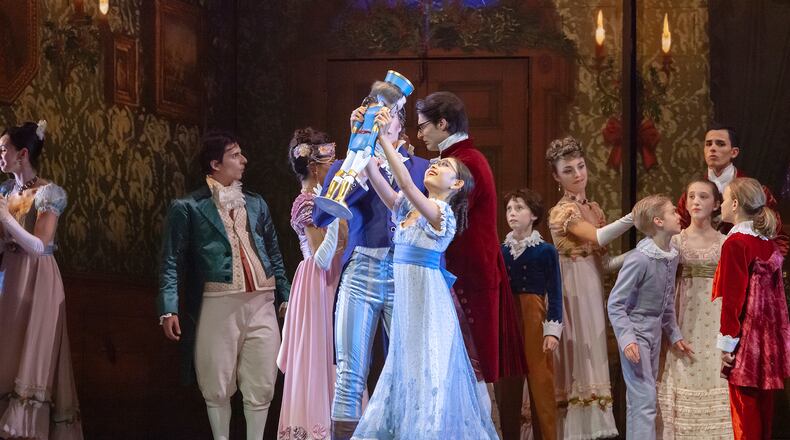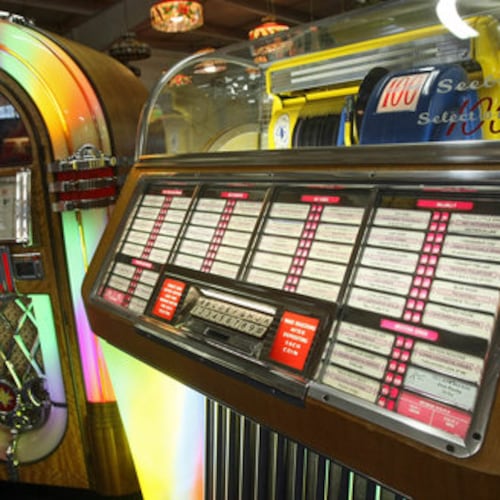The saying, “Bad dress rehearsal, good opening night,” was apt two years ago when Atlanta Ballet brought its new high-tech version of “The Nutcracker” to the Kennedy Center Opera House in Washington, D.C. In the most complicated scene change where set pieces, dancers, music, lighting and projection cues must coordinate perfectly, they didn’t. Automation systems didn’t work properly. A curtain got stuck on a nail. Dancers missed a cue, and one couldn’t enter because a giant piece of furniture was in the way.
While artistic director Gennadi Nedvigin talked with dancers, Atlanta Ballet production manager and technical director Dave Smith and general manager Thomas Fowlkes met with the travel-fatigued crew to answer any lingering questions. “No last-minute rehearsals. No emergency nothing,” said Fowlkes to the stage hands. “Just focus up.”
Two hours and a few deep breaths later, the curtain opened on the production’s national stage debut. All the elements came together, said Fowlkes, “and it was the most amazing opening night.”
The Kennedy Center performances were a dry run for “The Nutcracker’s” upcoming debut Dec. 4 at the Cobb Energy Performing Arts Centre.
As Atlanta Ballet’s largest and most technologically advanced production, “The Nutcracker” combines oversized scenery with advanced lighting and video projection techniques that rival some Broadway shows. But all these moving parts must come together with just the right alchemy to make magic on stage.
For 25 years, the Atlanta Ballet presented “The Nutcracker” at the Fox Theatre. John McFall’s version appeared annually starting in 1995. When Nedvigin became artistic director in 2016, he set about producing a new version of the holiday classic to help redefine the company’s artistic identity and build the international reputation he envisioned. The current version, choreographed by Yuri Possokhov, debuted at the Fox in 2018 and made its final Fox Theatre run in 2019.
Atlanta Ballet has performed most of its main stage repertory shows at the Cobb Energy Centre since 2008, but this is the first time for “The Nutcracker.” Smith foresees that they’ll have to make some adjustments, so he and the crew have spent almost three weeks preparing at the Mable House Barnes Amphitheatre in Mableton. Time is of the essence, since they’ll only have six days in the theater before the show opens for a three-and-a-half-week run.
Credit: Kim Kenney
Credit: Kim Kenney
They’ve practiced putting oversized set pieces together and taking them apart. They’ve run scene changes with low-tech manpower and advanced automation systems. And when the time comes, they will load and unload 10 trucks’ worth of set pieces, flooring, costumes and equipment to move to its new performance home.
On a recent chilly November morning, the stage’s green main curtain was drawn, enclosing the crew’s workspace behind the proscenium. The stage looked like the inner workings of a giant, half-assembled mechanical toy. As much as the magic onstage might inspire a young dancer, the backstage mechanics may stir the imagination of a budding engineer. It’s the kind of workshop that could easily be dreamed up by the production’s character, Drosselmeier, the mysterious clockmaker, toymaker and orchestrator of fantasy.
In reality, Smith coordinates this stealthy side of the ballet. Anything that happens on stage, except for Possokhov’s choreography, falls under his control. Son of a Tennessee construction contractor, Smith has been running technical theater since high school and is now a 35-year veteran production manager/technical director of opera, Broadway touring companies and the ballet. He’s planning and preparing as best he can, so that when they get to the theater, he said, “We figure it out.”
On a recent backstage tour, Smith and Fowlkes shared glimpses of the mechanics behind some of the production’s magical moments. On stage were two halves of a one-ton, 13-by-20-foot set piece painted like an antique leather-bound book engraved with gold. Motorized winches hung from the flies like giant, oddly placed ornaments, two of them attached to an edge of the book cover. As the motors started humming, the winches turned, winding up chains that brought the two halves of the book together.
Later, stage hands would connect the two book halves with four giant hinges controlled by hydraulic piston drives. Motorized winches would hoist the book onto a large steel bookstand, where its pages would open to become projection screens for images such as a Spanish bullfight, a French farmhouse and botanical prints of poppies and passion flowers.
Credit: Dave Smith
Credit: Dave Smith
A 31-foot-tall cabinet, painted gold in German period design, loomed at the far side of the stage. A fire escape attached to the back of it provided access to the cabinet’s three levels, where dancers would appear as life-sized toy soldiers and dolls. Standing on the top shelf, made of subway grate for lighting effects, evoked an odd sense of what a child’s toy might think or feel while looking out across the stage before slipping down a gold-painted slide to battle rats on the stage below. It’s the sort of intuitive jump made via a child’s imagination and E.T.A. Hoffman’s story, “The Nutcracker and the Mouse King.”
A long metal truss — called the mother truss — hovered across the upstage area, suspended from the flies by four two-ton motors. It controls scene changes in the Stahlbaum house set using three different automation systems. One system rotates the house’s four large panels, changing the house view from its wintry exterior to its cozy interior. Another system controls a billowing silk kabuki curtain at the end of Drosselmeier’s life-sized puppet show.
During the ballet’s most complicated scene change, eight one-ton motors inside the mother truss make the whole house disappear up into the flies as Marie, asleep in an armchair, fades into a dream world.
Smith has lost sleep over this scene change. It’s the one he’s rehearsed more than any other. The dreamscape Marie, now appearing toy-sized in an enormous armchair, waits ready, behind the house. Rats hide behind her chair. High-speed winches lift flat panels made to look like evergreen boughs on either side of the stage.
Ordinary things, like Marie’s book, armchair and cabinet, seem to grow tenfold as the giant chair and cabinet roll in. The sky — a map of the constellations — rotates. The house lifts out. A cityscape splits, courtesy of four stage hands who unplug its lighting system, then fold and stow the cityscape in the wings. Life-sized toys clamor out of the cabinet, and the chaos of the battle scene ensues. Meanwhile, dozens of dancers and stage hands are backstage, getting ready for entrances, changing costumes, etc.
“If everything’s not timed perfectly,” said Fowlkes, who managed the production’s first run, “I don’t want to say things will crash into each other, but it’s all got to work in plan. And because the music doesn’t stop, you can’t stop.”
The effects of COVID-19 pandemic have posed additional challenges. A disrupted supply chain has made trucks scarce. Smith has had countless phone conversations with his truck broker — some with colorful language — trying to wrangle the 10 tractor-trailers they’ll need to move the production to and from the theater.
Credit: Gene Schiavone
Credit: Gene Schiavone
Once Smith’s crew arrives at the venue, they’ll work 12-hour shifts to load in and assemble the set pieces, then practice some 300 cues. Lighting and projection designers will do the math needed to set proper angles and lenses before run-throughs with dancers and costumes begin.
Compared with the Fox Theatre, Cobb Energy Performing Arts Centre provides better sight lines and acoustics as well as more space backstage, so fitting dancers around set pieces will be less of a jigsaw puzzle, said Fowlkes. Some audience members may miss the Fox Theatre’s Moorish architecture and history-steeped atmosphere, but Fowlkes said Cobb Energy “puts the art first” and “lets us put our best foot forward.”
Thirty-five years after his first high school production, Smith still gets butterflies when the curtain opens and he hears the audience applaud his work. “It’s like having 2,600 bosses say you did a good job,” he said. “That, to me, does it. And I’m good. It was worth it.”
DANCE PREVIEW
“The Nutcracker.” Presented by Atlanta Ballet. Dec. 4-29. $30-$154, plus fees. Cobb Energy Performing Arts Centre, 2800 Cobb Galleria Parkway, Atlanta. 800-982-2787, atlantaballet.com.
About the Author
Keep Reading
The Latest
Featured




